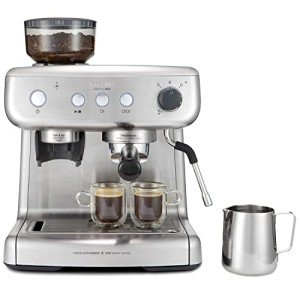The Ultimate Guide to Cappuccino Machines: Brewing the Perfect Cup
Cappuccinos are a cherished coffee beverage that combines the rich tastes of espresso with steamed milk and milk foam. For many, absolutely nothing tastes better than a homemade cappuccino crafted with precision. Nevertheless, reproducing the skill of a barista in the house needs the right equipment. This is where cappuccino machines enter play. This post dives into the various kinds of cappuccino machines, how they work, and suggestions for choosing the best one for your needs.
What is a Cappuccino Machine?
A cappuccino machine is a specialized developing gadget designed to make cappuccinos and other espresso-based beverages. These machines usually include an integrated espresso maker, a milk frother, and different controls for adjusting temperature and pressure. Cappuccino machines can be manual, semi-automatic, or totally automatic, using numerous levels of user control depending upon the intricacy of the machine.
Types of Cappuccino Machines
1. Manual Espresso Machines
- Description: These machines require users to run most functions by hand, including grinding coffee beans, tamping the grounds, pulling the espresso shot, and frothing the milk.
- Pros:
- Offers total control over the brewing process.
- Can produce high-quality, café-like espresso.
- Cons:
- Steeper knowing curve.
- Needs more time and effort.
2. Semi- Automatic Espresso Machines
- Description: Semi-automatic machines automate some procedures, such as water pressure. Users still need to grind coffee and froth milk manually.
- Pros:
- Balanced control and convenience.
- Allows space for experimentation.
- Cons:
- Still requires practical skills.
- Can be intricate for newbies.
3. Completely Automatic Espresso Machines
- Description: These machines automate the whole brewing process, from grinding to frothing. Users just select the wanted beverage.
- Pros:
- Extremely convenient and easy to use.
- Constant results with little effort.
- Cons:
- More expensive.
- Restricted control over the brewing process.
4. Super Automatic Espresso Machines
- Description: Similar to totally automatic machines, but these designs consist of features like a built-in milk frother and grinder. They prepare drinks with simply the touch of a button.
- Pros:
- Ultimate benefit; makes different beverages rapidly.
- Built-in cleansing and maintenance functions.
- Cons:
- High preliminary cost.
- Less hands-on experience with coffee making.
Secret Features to Consider
When picking a cappuccino machine, a number of functions can considerably affect efficiency and user experience. Here are some essential aspects to evaluate:
1. Develop Quality
- Products used (stainless steel, plastic)
- Durability and longevity
2. Capacity
- Water tank size
- Bean hopper capability
3. Frothing Capability
- Kind of frothing wand (manual, automatic)
- Steam pressure and temperature control
4. Reduce of Use
- Instinctive controls
- Cleaning and upkeep requirements
5. Rate
- Range from budget to high-end designs
- Consider guarantees and client assistance alternatives
6. Brand name Reputation
- User reviews and expert viewpoints
- Accessibility of replacement parts
The Brewing Process
To brew the best cappuccino at home, follow this procedure, despite the machine type:
- Prepare the Espresso: Use newly ground coffee beans and pull a double shot (around 2 ounces) of espresso.
- Froth the Milk: Steam fresh milk to a temperature level about 150 ° F( 65 ° C)using the steam wand or automatic frother.
- Combine: Pour the steamed milk over the espresso, followed by a layer of milk foam (equal parts espresso and steamed milk, with about 1 cm of foam).
For a visual representation, here's a basic table comparing the attributes of the cappuccino machine types:
| Machine Type | Control Level | Ease of Use | Cost Range | Ideal For |
|---|---|---|---|---|
| Manual Espresso Machine | High | Challenging | Low to Medium | Coffee enthusiasts, perfectionists |
| Semi-Automatic Machine | Medium | Moderate | Medium | Home baristas, hobbyists |
| Fully Automatic Machine | Low | Easy | Medium to High | Casual drinkers |
| Super Automatic Machine | Very Low | Extremely Easy | High | Hectic experts |
Regularly Asked Questions (FAQs)
What is the very best milk to use for cappuccinos?
Whole milk is frequently preferred for frothing due to its fat content, which creates a creamy texture. Nevertheless, options like almond milk, oat milk, or soy milk can be utilized, though they may need various frothing methods.
How do I tidy my cappuccino machine?
A lot of machines feature particular cleaning directions. Normally, you need to regularly clean the group head, steam wand, and drip tray. For automatic machines, numerous models feature self-cleaning cycles.
Can I use pre-ground coffee rather of entire beans?
Yes, you can use pre-ground coffee. However, newly ground coffee normally produces a more tasty espresso due to the oils in the beans being preserved.
How much should I invest in a cappuccino machine?
The cost varies substantially based upon functions, brand name, and quality. A basic, great quality machine might begin around ₤ 200, while high-end very automatic machines can surpass ₤ 2,000.
How frequently should I replace my cappuccino machine?
With proper maintenance, a high-quality cappuccino machine can last for several years. However, you might think about upgrading if you find your machine no longer satisfies your brewing requires or experiences performance concerns.
Cappuccino machines are powerful allies in providing the best brew at home. Whether you prefer manual interaction with your coffee or prefer the convenience of completely automated machines, comprehending the numerous types and their features will assist you in making the ideal choice. By investing in the perfect machine for your needs and using the right methods, anybody can take pleasure in a barista-quality cappuccino from the comfort of their own kitchen area. With a little bit of perseverance and imagination, the art of cappuccino brewing can become a delightful routine, brewing not just coffee but minutes of pleasure.

